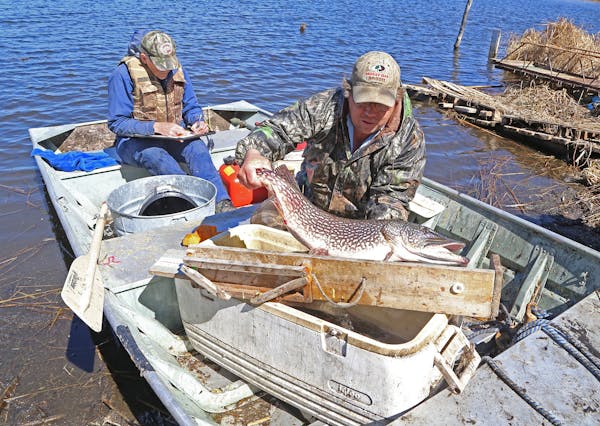After the Red Lake walleye fishery collapsed in the 1990s, state, federal and Indian officials shut down fishing and dumped millions of walleye fry in the upper and lower portions of the lake, rejuvenating the fishery.
And when walleye numbers fell precipitously on Leech Lake in the early 2000s, officials stocked millions of walleye fry, and, combined with other factors, the lake recovered.
So why not dump millions of tiny walleye fry into Lake Mille Lacs to help its troubled walleye fishery?
Because, Department of Natural Resources officials say, the Mille Lacs situation is much different. And the genetics of Mille Lacs walleyes are distinct, complicating possible stockings.
"We're not planning on stocking walleyes in Mille Lacs,'' Don Pereira, DNR fisheries chief, told legislators at the Capitol last week in a rare hearing on the most popular fishing lake in Minnesota.
The problem at Mille Lacs — where the DNR will impose the lake's tightest walleye regulations ever this season because of declining walleye numbers — isn't a lack of spawning female walleyes, as was the case at Red Lake, Pereira said.
"There are plenty of females in the lake,'' Pereira told the House Mining and Outdoor Recreation Policy Committee. "And they are producing plenty of young fish.''
The problem, Pereira said: "Young walleyes are not surviving. Somewhere between the first fall and the third fall, the mortality has been elevated.''
The root cause remains uncertain. But northern populations are at record highs, and they eat walleyes. And large walleyes eat small walleyes. Water clarity has improved, possibly making young walleyes more vulnerable to predation. The smallmouth bass population has exploded in recent years, but officials say walleyes are not a big part of their diet.
The problem at Red Lake was far different. There, the female spawning biomass had collapsed from overfishing.
"We knew the population was so limited, it would take a long time to recover on its own, so we made the difficult decision to aggressively stock walleyes for three years to help the lake recover," Pereira said.
But messing with Mother Nature meant the genetics of the Red Lake walleyes were affected. Red Lake walleyes are distinct genetically from walleyes in other lakes. And unlike decades ago, fisheries researchers now know that mixing genetically different fish raises potential problems.
It can cause "outbreeding depression,'' Pereira said. When that happens, the two strains of fish interbreed and reproduce, but the genetics get disrupted, he said. The offspring might have lower survival and reproductive success.
"We don't want to add another problem to Mille Lacs,'' he said. So if female spawning mass continues to decline and officials decide to stock the lake, eggs and sperm from Lake Mille Lacs walleyes would be used, Pereira said.
"That's why the decision to stock Red Lake was agonizing,'' he said. Fry from the Pike River hatchery at Lake Vermilion were used, possibly forever altering the genetics of Red Lake walleyes. "The Red Lake genome may be gone now,'' he told legislators.
It doesn't appear the mixing of genetics at Red Lake has hurt the walleye population; it has been thriving.
At Leech Lake, officials used fry taken from the nearby Boy River, which were much closer genetically to Leech Lake walleyes. And there appear to be no genetic problems there, either.
While Mille Lacs female spawning biomass remains well above Red Lake's levels, and is high enough to replenish the lake without stocking, the recent population trend is down. That's concerning and a reason for this season's tight regulations, which allow anglers to keep just one walleye 19 to 21 inches long or one over 28 inches.
Said Pereira: "Larger females are in decline now because young fish aren't surviving to replenish the spawning stock. It's not at Red Lake levels, but we don't want it to get there."
The initial presence of young walleyes, which later disappear, tells the DNR something else: that the walleye decline isn't caused by Indian netting of fish during the spawning season, a major source of irritation for many anglers and business owners.
The problem with the bands' spring netting — and with the DNR's regulations for anglers — is that both have encouraged the keeping of smaller fish. Eighty percent of the bands' harvest are male walleyes, Pereira said.
"We targeted too much fishing mortality on fish between 15 and 18 and 20 inches,'' he said.
That will change in the future, even when walleyes rebound.
"We're not going to focus fishing mortality on a narrow size range of fish any more,'' he said. "We don't want to repeat the mistakes of the past.''
Doug Smith • dsmith@startribune.com

Going to Wolves or Twins tonight? How to get there (and maybe avoid traffic).
Ex-Gophers forward Payne transferring to Texas A&M
Focusing on bringing football film into frame
Analysis: Golf has two dominant forces in Scheffler and Korda. It didn't happen overnight

